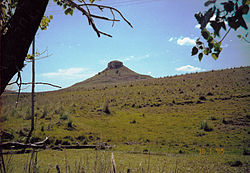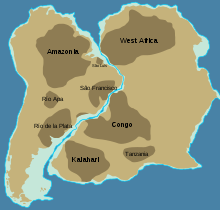Geology of Uruguay


Thegeology of Uruguaycombines areas ofPrecambrian-agedshieldunitswith a region ofvolcanic rockerupted during theCretaceousand copioussedimentaryfaciesthe oldest of which date from theDevonian.Big events that have shaped the geology ofUruguayinclude theTransamazonian orogeny(2000million years ago(mya)), the breakup ofRodinia(700–500mya) and theopening of the South Atlantic(~145 mya).
Shield region
[edit]
ThePrecambrianshieldin Uruguay includes part ofRío de la Plata craton,an extensive area of stablecrystallinebasement rockunderlying Uruguay and large areas of easternArgentinaand southernBrazil.The shield in Uruguay goes under the name of Rio Grande do Sul—Uruguay Shield and includes parts ofSouthern Brazil.[2]Though the Río de la Plata Craton underlies practically all of Uruguay, it only shows up in the south and east of the country since in other parts of the country, it is covered by younger volcanic rocks or sediments. The shield was formed during twoorogenicevents; one 2000million years ago(mya) for the western part and another 700–500 mya for the eastern part.[3]The later orogenic event is the result of theaccretionof blocks andterranesin the aftermath of the breakup ofRodiniawhenSão Franciscoand Río de la Plata cratons formed one plate in the west of theAdamastor Ocean.[4]The eastern part of the Uruguayan shield region is crossed by two majorshear zonesboth running roughly in north-south direction thedextralSarandí del Yí-Piriápolis Shear Zoneand thesinistralSierra Ballena Shear Zone.[3]West of Sarandí del Yí Shear Zone the Río de la Plata Craton is intruded by theLate PaleoproterozoicFlorida dyke swarm.[5]
The area between Sarandí del Yí and Sierra Ballenashear zones–that is the Nico Pérez Terrane– is made ofmetamorphicandgranitoidrocks which are the oldest rocks in Uruguay.[6]It has not been established to which degree this terrane belongs to or has affinity with the Río de la Plata Craton.[6]The rocks of Nico Pérez Terrane formed originally in theArcheaneon andPaleoproterozoicera and much were later affected by theBrasiliano orogenyinNeoproterozoicera.[6]
Sedimentary formations
[edit]After theassemblyof the finalshieldconfiguration the territory of Uruguay have been covered by several sedimentary formations ranging fromDevoniansandstonestoQuaternaryloess.All of the sedimentary formations covers only patches of the country sincedepositionhave not been uniform anderosionhave cleaned surfaces, creeks and shores.
Sedimentary rocksofLower Devonianage are found in the central part of Uruguay being exposed as a narrow east-west to northeast oriented band. The upper and better known part of thissequenceis made up ofsandstone.The lower sandstones of this sequence have characteristics similar to theFurnas FormationofSão PauloinBrazil.[7]During theLate Paleozoicthe territory of Uruguay was affected by theKaroo Glaciationand was subsequently covered by ice lobes of the greatice sheetthat covered large parts ofGondwana.Glacial striaeonshalesandvarve-like sediments found in Uruguay have been associated with this glaciation.[8]
During the earlyriftingstages of the South Atlantic the area of southernParaná Basinsuffered a gentle uplifting that deviated sediments into the Tacuarembó region of Uruguay. These changes led to the formation of the Itacuanbú and Tacuarembó formations during the MidJurassicto EarlyCretaceous.Parts of theTacuarembó formationcame to be preserved thanks to a unit of the Paraná traps, the Arapeybasalts,that erupted 132 mya and covered the sediments.[9]
Paraná traps
[edit]In the north of Uruguay, volcanic materials from theParaná continental flood basalt provinceform a majorlithologicalunit extending beyond Uruguay's borders into Argentina and Brazil, with parts of it now lying inNamibiaon the other side of the Atlantic due toplate tectonics.This volcanic material erupted in theCretaceousperiod during the opening of theSouth Atlanticand has been linked to theTristan da Cunhaplume.[10]The bulk of this volcanic material isbasaltbut there arerhyolitesas well. Associated with this volcanism are alsosyeniteand othergranitoidintrusionsexposed asoutcropsin small areas of Southeastern Uruguay.[11]Although volcanic rocks of the Paraná volcanism underlies more than half of Uruguay, they have in many areas been covered by younger sediments so that the lavas only crop out as a geological province in the Uruguayan northwest.[12]
References
[edit]- ^Gaucher, C.; Finney, S. C.; Poiré, D. G.; Valencia, V. A.; Grove, M.; Blanco, G.; Pamoukaghlián, K.; Peral, L. G. (2008)."Detrital zircon ages of Neoproterozoic sedimentary successions in Uruguay and Argentina: insights into the geological evolution of the Río de la Plata Craton".Precambrian Research.167(1): 150–170.Bibcode:2008PreR..167..150G.doi:10.1016/j.precamres.2008.07.006.hdl:11336/74329.
- ^Butler, Louis W. 1970.Shallow structure of the Continental Margin, Southern Brazil and Uruguay.GSABulletin.
- ^abBossi, Jorge; Gaucher, Claudio (2004), "The Cuchilla Dionisio Terrane, Uruguay: An Allochthonous Block Accreted in the Cambrian to SW-Gondwana",Gondwana Research,7(3): 661–674,doi:10.1016/S1342-937X(05)71054-6
- ^Benjamin Bley de Brito Neves,Mário da Costa Campos Neto and Reinhardt Adolfo Fuck. 1999.From Rodinia to Western Gondwana: An approach to the Brasiliano-Pan African Cycle and orogenic collage
- ^Mazzucchelli, Maurizio; Rivalenti, Giorgio; Piccirillo, Enzo Michele; Vitorio Girardi, Vicente Antonio; Civetta, Lucia; Petrini, Riccardo (1995). "Petrology of the Proterozoic mafic dyke swarms of Uruguay and constraints on their mantle source composition".Precambrian Research.74(3): 177–194.doi:10.1016/0301-9268(95)00014-V.
- ^abcSánchez Bettucci, Leda; Cordani, Umberto; Loureiro, Judith; Peel, Elena; Fort, Santiago; Sato, Kei (2021)."The Nico Pérez terrane (Uruguay) and its archean and paleoproterozoic inheritance".Andean Geology.48(3): 442–471.doi:10.5027/andgeoV48n3-3345.RetrievedNovember 28,2021.
- ^Harrington, Horacio J. Uruguay - Handbook of South American Geology. 1956.
- ^Lawrence A. FrakesandJohn C. Crowell.1969.Late Paleozoic Glaciation: I, South America,GSA Bulletin
- ^Perea, Daniel; Soto, Matías; Veroslavsky, Gerardo; Martínez, Sergio; Ubilla, Martín (2009), "A Late Jurassic fossil assemblage in Gondwana: Biostratigraphy and correlations of the Tacuarembó Formation, Parana Basin, Uruguay",Journal of South American Earth Sciences,28(2): 168,doi:10.1016/j.jsames.2009.03.009
- ^Stewart, Kathy; Turner, Simon; Kelley, Simon; Hawkesworth, Chris; Kirstein, Linda; Mantovani, Marta (1996), "3-D,40Ar-39Ar geochronology in the Paraná continental flood basalt province ",Earth and Planetary Science Letters,143:95,doi:10.1016/0012-821X(96)00132-X
- ^Lustrino, M.; Gomes, C.B; Melluso, L.; Morbidelli, L.; Muzio, R.; Ruberti, E. and Tassinari, C.C.G.Early Cretaceous Magmatic Activity in Southeast Uruguay: Trace Elements and Sr-Nd Isotopic ConstraintsArchived2011-07-20 at theWayback Machine
- ^David S. Thiede and Paulo M. Vasconcelos. 2010.Paraná flood basalts: Rapid extrusion hypothesis confirmed by new 40Ar/39Ar results.Geologyvol 38.
External links
[edit]- National Mining and Geology Office(in Spanish)
- Soil, topography, climate and agro-ecological zones of UruguaybyFood and Agriculture Organization
- Geological evolution of Uruguay(in Spanish)by Agronomy Faculty,Universidad de la República,Uruguay

